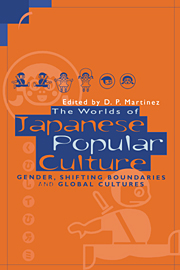Chapter 9 - The Cult of Oguricap
Or, how women changed the social value of Japanese horse-racing
Published online by Cambridge University Press: 22 September 2009
Summary
Introduction
This chapter is mainly concerned with a race horse named Oguricap and, as a complement, with a jockey named Take Yutake. Their story begins in the early 1980s when the social status of horse-racing in Japan began to change and improve. This was brought about mainly by the efforts of the Japan Racing Association (JRA); coupled with the fortuitous appearances of two successive triple crown horses, Mr CB (1983) and Simbori Rudolf (1984) on the courses. But the really drastic change began in the year 1988 when there emerged two great popular heroes: Oguricap, the horse known as the gray monster, and Take Yutaka, the brilliant, handsome young jockey. Women of all ages were fascinated with these new heroes and they not only created a new atmosphere at race courses, which had been dominated by rather melancholy-looking men, but they also transformed this socially unacceptable form of gambling into an enjoyable, if not fully respectable, form of leisure.
The phenomena focussed around the horse – beginning with the sudden increased enthusiasm for him – I shall term “the cult of Oguricap”, for three reasons. First, the extent to which he was, and still is after retirement, admired is really extravagant (as will be shown below) and this alone accords with a dictionary definition of a “cult”. Second, he has been surrounded by myth and deified as it were by his followers, and the process of the formation of followers is comparable to that of a new religion.
- Type
- Chapter
- Information
- The Worlds of Japanese Popular CultureGender, Shifting Boundaries and Global Cultures, pp. 167 - 180Publisher: Cambridge University PressPrint publication year: 1998



